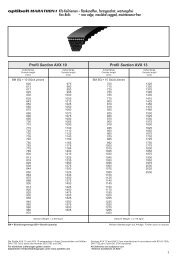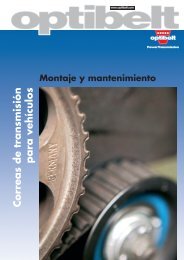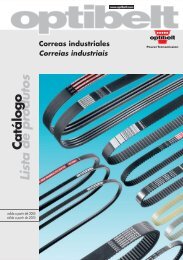manual tecnico industrial.pdf - La casa de las correas
manual tecnico industrial.pdf - La casa de las correas
manual tecnico industrial.pdf - La casa de las correas
You also want an ePaper? Increase the reach of your titles
YUMPU automatically turns print PDFs into web optimized ePapers that Google loves.
44<br />
Poleas acanaladas trapeciales<br />
Poleas acanaladas trapeciales para <strong>correas</strong> múltiples Kraftband<br />
Tabla 11: Poleas acanaladas trapeciales para <strong>correas</strong> múltiples Kraftband con <strong>correas</strong> trapeciales estrechas ISO 5290<br />
Perfil d a<br />
3V/9J<br />
67 hasta 90 36<br />
> 90 hasta 150 38<br />
> 150 hasta 300 40<br />
> 300 42<br />
α° b1 ± 30‘ ≈<br />
δ h 1max δ h 2max t min e Tol e 1) Σ Tol e 2) f min d a min<br />
8,9 0,20 0,30 8,9 10,3 ± 0,25 ± 0,5 9 67<br />
180 hasta 250 38<br />
5V/15J > 250 hasta 400 40 15,2 0,25 0,40 15,2 17,5 ± 0,25 ± 0,5 13 180<br />
> 400 42<br />
315 hasta 400 38<br />
8V/25J > 400 hasta 560 40 25,4 0,30 0,50 25,4 28,6 ± 0,40 ± 0,8 19 315<br />
> 560 42<br />
Para más <strong>de</strong>talles ver la norma ISO 5290.<br />
1) Tolerancia para la distancia entre centros «e» <strong>de</strong> dos canales contiguos.<br />
2) <strong>La</strong> suma <strong>de</strong> todas <strong>las</strong> diferencias <strong>de</strong> <strong>las</strong> dimensiones nominales «e» para todas <strong>las</strong> distancias entre ranuras no <strong>de</strong>berá superar el valor indicado.<br />
<strong>La</strong> norma internacional ISO 5290 especifica <strong>las</strong> dimensiones<br />
fundamentales <strong>de</strong> <strong>las</strong> poleas acanaladas para los perfiles 3V/9J,<br />
5V/15J, 8V/25J. El ancho superior <strong>de</strong> la ranura b1 se utiliza como<br />
medida <strong>de</strong> referencia básica para la estandarización <strong>de</strong> los<br />
canales y <strong>de</strong> <strong>las</strong> <strong>correas</strong> trapeciales unidas. Los canales <strong>de</strong> la<br />
polea y <strong>las</strong> <strong>correas</strong> trapeciales unidas se consi<strong>de</strong>ran como una<br />
unidad en la norma ISO 5290.<br />
Los valores <strong>de</strong> δ h1 y δ h2 se seleccionaron <strong>de</strong> forma que:<br />
1. <strong>La</strong> banda <strong>de</strong> unión <strong>de</strong> <strong>las</strong> <strong>correas</strong> no se apoyase sobre el<br />
diámetro exterior <strong>de</strong> la polea, para evitar que se <strong>de</strong>spegue la<br />
banda <strong>de</strong> <strong>las</strong> <strong>correas</strong>.<br />
2. <strong>La</strong>s <strong>correas</strong> unidas quedasen lo suficientemente introducids en<br />
el canal <strong>de</strong> la polea para asegurar la transmisión <strong>de</strong> potencia.<br />
Perfil d d<br />
SPZ<br />
SPA<br />
SPB<br />
SPC<br />
Bor<strong>de</strong>s<br />
redon<strong>de</strong>ados<br />
y<br />
x<br />
71 to 80 34<br />
> 190 38<br />
100 to 118 34<br />
> 80 38<br />
160 to 190 34<br />
> 190 38<br />
250 to 315 34<br />
> 315 38<br />
α° b1 ± 30’ ≈<br />
b 1 = ancho efectivo<br />
d a = diámetro efectivo<br />
c t min e Tol e 1) Σ Tol e 2) f min d d min<br />
b 1<br />
Los flancos <strong>de</strong> los canales <strong>de</strong> la polea <strong>de</strong>berán ser rectos, al menos<br />
en la proporción <strong>de</strong> d a – 2 δ h 2.<br />
Tabla 12: Poleas acanaladas para <strong>correas</strong> múltiples Kraftband con <strong>correas</strong> trapeciales estrechas <strong>de</strong> perfil SPB, SPC<br />
y<br />
c<br />
y<br />
9,7 2,0 11 12,0 ± 0,3 ± 0,6 8,0 71<br />
12,7 2,8 14 15,0 ± 0,3 ± 0,6 10,0 100<br />
16,3 3,5 18 19,0 ± 0,4 ± 0,8 12,5 160<br />
22,0 4,8 24 25,5 ± 0,40 ± 0,8 17,0 250<br />
δh 2<br />
δh 1<br />
d a<br />
x =<br />
<br />
y =<br />
<br />
R z 25<br />
R z 100





